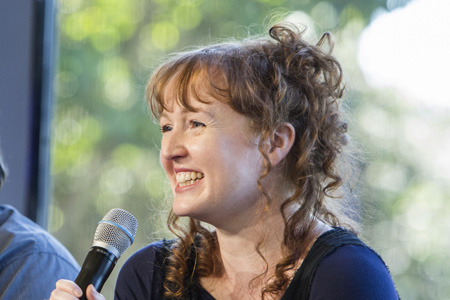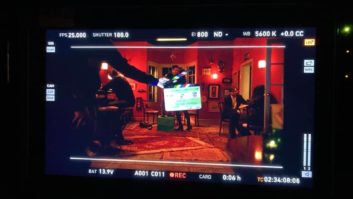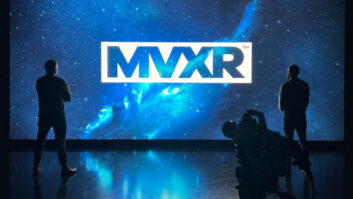
Respectively CEO and CTO, and driven to be in the vanguard of where all video is intuitively interactive, this successful Dublin start-up already counts QVC, Viacom, AOL and Qyou amongst its clients, and now it has the Ediflo Pro platform, a cloud-based SaaS system that allows the user to add video services via Object Based Broadcasting (OBB).
The message to the likes of BT is simple: when you have finished fussing over 4K and HDR, interactive video apps distributed on multiple platforms are the next big thing. In fact they are here now, but where did Axonista come from in terms of its pedigree?
“I worked for a number of years as a sports broadcaster, and Daragh’s background is in enterprise development. It happened in typical Irish start-up fashion, created over a few pints in a pub,” said McHugh. “There was the very experimental stage, before the ubiquitous mobile device became what we have today.
“We did trials with Irish broadcasters. We produced companion apps for specific shows, and looked to see how we could help the editorial flow,” she added. “And then we did a project with TV3 which was pretty ambitious for 2013. It was a completely synced companion app for TV3’s entire primetime schedule of 40 different shows. That project gave us a really good understanding of what worked and what did not work with second screen. We also learnt what sort of assets were available, and how editorial could shape interactive experiences.”
What McHugh and Ward discovered was that anything in a live setting – sports, shopping, fashion, news and current affairs – worked brilliantly.
“If you were a little bit removed from the content it was difficult to create an experience that actually added any value for the viewers. So we have concentrated on, and have developed our product to target it towards live shows,” said McHugh.
This is not about creating more than a two-screen experience, but a single unified experience. “If you are watching on a mobile device, it works perfectly for that device. If there is a caption that looks like it should be tapped, it is tap-able and it does something, but it does not interrupt the editorial of the show itself,” she said.
Innovate or die away
Jump forward three years from the TV3 trials and Axonista has several core products; Ediflo Live (scheduling and playout), Ediflo Library (DAM), Remoco (interactive video), and now the professional version of Ediflo. Its mission statement could be, ‘We create interactive apps that can be distributed on multiple platforms, and managed by producers’.
“If you are in TV and you are not innovating, you are not going to be around in ten year’s time. We work with innovators who can look forward and see how the market is shifting, and be there at that time,” said McHugh. “For people like QVC and the big global broadcasters, this is a no brainer. And then there are the new digital natives, and a large version of those is AOL. It has lots of different video properties and is really open to doing new and interesting things because its target market is people who have maybe never actually had TV or cable, and are used to viewing on different mobile devices.
“And then we have the people who are getting into broadcasting for the first time and don’t have all that legacy stuff,” she added.
Ward contributed: “We still want to be working with broadcasters and other companies who are influencing the editorial. We always like to take video from the broadcaster we are talking to and say, ‘Here’s your content and this is what it’s like if you use our system to make it interactive on devices. We are not going to change editorial’. The content has come off the screen now and has come onto all the little screens, and it is about that intuition of how it works on different devices.”
McHugh said: “It could eventually come completely off the screens and just be on any flat surfaces or in VR environments. Anywhere video can play it can be interacted with, and that’s where we want to be.”
Axonista is six years old. The three products were created by just 15 staff. How will it find the talent and funding to expand?
“That is a big issue,” said McHugh. “Luckily enough I have a technical co-founder who has built good software teams before. This is Daragh’s third company.”
Ward added: “Dublin has a vibrant start-up community that is technically heavy. Google, Facebook, Twitter and many Silicon Valley companies have European HQs there, and they attract large numbers of engineering talent.
“In some ways that is difficult, because we are not competing with those guys, but nobody spends their entire career at Google. They come out the other side and look for a new challenge. We are able to tell the story of what we are doing and attract people that way,” he continued.
Axonista raised its seed money and it has become profitable. The next step after growing the team will be penetrating the American market more competitively.
“We are looking right now for a really good venture capital partner who will inject the right amount, but also give us good connections and the ability to fill gaps in our team,” said Ward.
This is a sensible foot in the past, foot in the future thinking. “We continue to work with Irish broadcasters, TV3 particularly: we do all its free player stuff on different platforms from IOS, Android and Roku to Xbox,” said McHugh. “Ireland is a great market to test things because it is a kind of mini UK market and a very mini US market in terms of demographic breakdown. The QVC Apple TV app has got us the most attention. When we got to do that it enabled us to show what the future of TV really looks like.”
Everywhere video can be played
Axonista started as a services company doing second screen apps and developed by taking all the technology it had been building for apps creation and coalescing it into solid product. It had been selling an enterprise version of Ediflo, meaning involvement in the customer implementation. The new professional version is something users can set up for themselves. It has a creative team that handles design to prototype, and a development team that builds the prototype out.
“We work everywhere where video can be played. Our product side is broad: there is the asset management, which you could use on its own to create an OTT service. We work with partners where we have features we don’t want to build ourselves. We want to focus on the interactive graphics part of it,” said Ward. “We work with Yospace for ad insertions at TV3. We work with Pay Wizard for payments, and for automated content recognition we work with Civolution.”
Axonista software is a cloud-based subscription deal. Ediflo is all about workflow, and the new professional system hits the market in Q3.
“It is an editorial workflow system but is designed to be incorporated into your existing workflow. We do not want to ask you to change anything around, so we have very easy integrations. We can integrate our scheduling piece into your scheduling system, and you don’t necessarily have to use Ediflo to create the schedule. You would use it to drive the digital side and drive the apps,” he added.
Axonista is working with a number of customers to build out Ediflo Pro and make it 100 per cent ready. Ward went into demo mode.
“This is the asset library of Qyou, and you can see we can store the content and metadata for all of the videos these guys use to comprise their offering. They are both linear and on-demand so they use the library to manage their digital assets in the cloud,” he said.
“On the scheduling side Qyou curates short form content for the web, so lots of really good youth oriented short-form video, and they put it all together as shows with presenters who call out what’s happening and the content makers as guests. They make a whole show out of it.”
The point here is that the run down of media assets in an hour-long show were there to frame accuracy, and played out from the cloud. The interactive TV part of the Axonista strategy is Remoco.
“It’s an SDK that you can drop into your own apps,” said Ward. “And we can build an app for you based around this. You can have interactivity against one show out of your schedule or around anything you want.”
This led to QVC as a user. “It is really simple. That’s the real killer thing about it. So many technology companies just try to put widgets everywhere and say how clever they are. This is just intuitively perfect,” said Ward.
In the prototype seen (QVC had baked in the sell data panel on its pages) the Axonista replacement panel is an interactive overlay offering many more benefits. These can be partly identified from a demo experience with presenter Craig Doyle.
“Craig is going to start by asking his audience a question, and he will encourage them to engage on Twitter to reply. The question is, ‘which is more important, performance or victory, and why?’ He wants people to call the show and include the hash tag, and this is fine for TV again, similarly to QVC. But in a device what you are actually asking people to do is leave the app they are watching and go to twitter and launch. They then have to remember how to spell the hash tag and try to remember the question, just as a friend posts a crazy picture of his cat,” said McHugh.
Clean feed without the graphic
What Axonista worked out, which it has presented to BT as an idea was: “Why not give us a clean feed without the graphic. This is a very similar graphic but it is native. The guys in the studio do not have to change what they are saying, change the editorial or change the production. We can take the data they are sending the Chyron and funnel it down to the app and display it in a way that looks the same. But when you tap it you can respond to that poll, put in your bit of guff and Tweet, and you have not missed a beat or left the show,” said Ward.
“This really increases engagement: when we talk to our users about the results that came out, some of them are pretty astounding,” he continued. “For QVC it is a natural progression, but not yet for broadcasters and BT. Those guys are focussed on 4K and HDR but there will be a thing that will be next after that, and what we are trying to do with Ediflo Pro is to drive that market and to put it in front of decision makers and say this thing is possible now.”
Axonista does not make the mistake of claiming it is unique. “There are other people doing what we are doing, and if there wasn’t I would be worried. It is always a good indication you are doing the right thing if somebody has also thought of it,” said McHugh. “The difference is our keen focus on the user experience and also on the editorial experience. Producers are the storytellers; so enabling them to use more ways of telling their story is really the thing for us. OBB is the next phase in video delivery for content makers who want to stay ahead of their competitors.”







